THE WORLD BIRDS - An Online Bird Book
PASSERELLIDAE
Order Passeriformes Family Passerellidae
PASSERELLIDAE
The Passerellidae family includes New World brush-finches, juncos, New World sparrows, and towhees. These species were formerly included in the Emberizidae faimiy which now only contains the Old World buntings, They are small seed-eaters with a finch-like bill. In addition to seeds they also eat insects, especially when feeding their young. They build cup-shaped nests.
New World sparrows
Order Passeriformes Family Passerellidae
The sparrows on this page belong to the Passerellidae family. These sparrows are found in the New World. There are also birds called sparrows in the Passeridae family.
Genus Aimophila
The name Aimophila means "thicket loving" which describes one of their preferred habitats. They eat seeds, insects, spiders and forage on the ground. The cup shaped nest is made out of twigs and grass. It is usually located on the ground, but also in shrubs.
Sparrow,_Oaxaca Aimophila notosticta
.Description: The Oaxaca sparrow has mainly brown upperparts with black streaks. It has a chestnut crown, white supercilium, white eye-ring, black lores, and a black streak in th malar region. The underparts are pale grey. The Oaxaca sparrow is about 17 cm long.
Range: Mexican state of Oaxaca.
Habitat: Dry forests and thornscrub.
Diet: Probably seeds, insects, spiders.
Conservation status: Least Concern.
Image by: 1) Dominic Sherony 2) Jerry Oldenettel 3) Nick AthanasRange: Mexican state of Oaxaca.
Habitat: Dry forests and thornscrub.
Diet: Probably seeds, insects, spiders.
Conservation status: Least Concern.


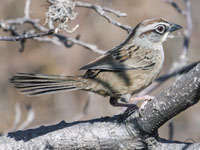
Sparrow,_Rufous-crowned Aimophila ruficeps
Description: The rufous-crowned sparrow has a brown back with darker streaks and grey underparts. The crown is rufous, and the face and supercilium are grey with a brown or rufous streak extending from each eye and a black malar streak. The rufous-crowned sparrow has a grey bill; the similar rufous-winged sparrow has a yellow bill. It is up to 15 cm long. Rufous-crowned has one stripe on lower face; rufous-winged has 2 stripes.
Range: Southwestern USA, Mexico.
Habitat: Shrubs, rocky areas.
Diet: Seeds, insects, spiders.
Conservation status: Least Concern.
Image by: 1) Jerry_Ting - California 2) JN Stuart - Nevada 3) Bill Bouton - California 4) Jamie_Chavez Range: Southwestern USA, Mexico.
Habitat: Shrubs, rocky areas.
Diet: Seeds, insects, spiders.
Conservation status: Least Concern.

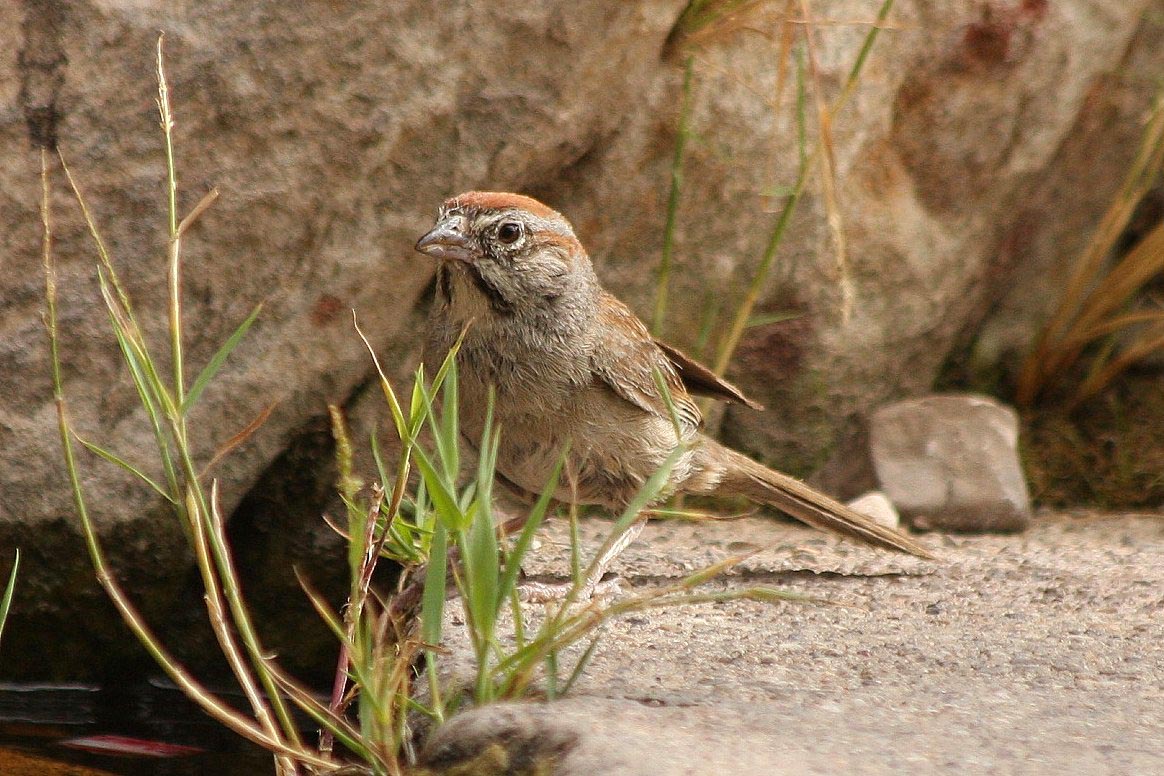

Sparrow,_Rusty Aimophila rufescens
Description: The rusty sparrow has chestnut upperparts. It has a brown crown with narrow light median line, whitish supercilium, black eye-line, and a white throat edged with black. The breast is greyish-brown, the belly whitish, and the flanks are brown. The rusty sparrow is up to 20 cm long.
Range: Western Mexico, Central America.
Habitat: Forests, montane shrubland.
Diet: Seeds, insects, spiders.
Conservation status: Least Concern.
Image by: 1, 2, 3) Jerry Oldenettel - Belize 4) Nigel_Voaden - MexicoRange: Western Mexico, Central America.
Habitat: Forests, montane shrubland.
Diet: Seeds, insects, spiders.
Conservation status: Least Concern.



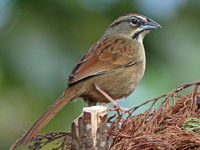
Genus Ammodramus
These birds are relatively small, with large bills, flat heads and short tails. They are usually found in grasslands or marshes and are often fairly inconspicuous, except for the yellow-browed sparrow which is the least shy of the three species. They feed mainly on the ground eating seeds, insects, and spiders. Their nests are on the ground, made out of grasses, and may be partially covered with a side entrance.
Sparrow,_Grasshopper Ammodramus savannarum
Description: The grasshopper sparrow has upperparts streaked with brown, grey, black, and white. the tail is brown. It has a dark brown crown with a narrow white median stripe, a brown face, and a light eye-ring. The breast is light brown and the belly is white. The grasshopper sparrow is 10 to 14 cm long. The similar Baird's sparrow has some stripes on its breast while a Grasshopper sparrow's breast is plain.
Range: Much of North America and part of Central America.
Habitat: Grasslands.
Diet: Main insects, especially grasshoppers; also seeds. It forages on the ground.
Conservation status: Least Concern.
Image by: 1) Jerry Oldenettel - Texas 2) Dominic
Sherony 3) Ken Schneider 4) Charlie Westerinen - CaliforniaRange: Much of North America and part of Central America.
Habitat: Grasslands.
Diet: Main insects, especially grasshoppers; also seeds. It forages on the ground.
Conservation status: Least Concern.



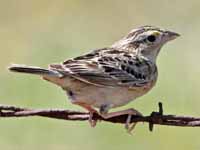
Sparrow,_Grassland Ammodramus humeralis
Description: The grassland sparrow has brownish-grey upperparts with black streaks. It has a narrow white eye-ring and yellow that extends from the lores towards the eyes. The underparts as off-white. The grassland sparrow is about 13 cm long. Its cup-shaped nest is located on the ground.
Range: South America
Habitat: Mainly grasslands.
Diet: Seeds; also insects.
Conservation status: Least Concern.
Image by: 1) Lip Kee Yap - Argentina 2, 3) Dario
Sanches - Brazil 4) Edwin_Harvey - ArgentinaRange: South America
Habitat: Mainly grasslands.
Diet: Seeds; also insects.
Conservation status: Least Concern.



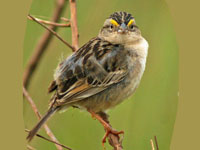
Sparrow,_Yellow-browed Ammodramus aurifrons
Description: The yellow-browed sparrow has brownish-grey upperparts with lighter streaks. It has a wide yellow supercilium. The underparts are pale grey. The yellow-browed sparrow is about 13 cm long.
Range: Bolivia, Brazil, Colombia, Ecuador, Peru, and Venezuela.\
Habitat: Grassy areas.
Diet: Mainly seeds; also insect and spiders.
Conservation status: Least Concern.
Image by: 1) Tom Friedel (BirdPhotos.com) - Venezuela 2, 3) Barloventomagico - Venezuela 4) Nick Athanas - Ecuador Range: Bolivia, Brazil, Colombia, Ecuador, Peru, and Venezuela.\
Habitat: Grassy areas.
Diet: Mainly seeds; also insect and spiders.
Conservation status: Least Concern.
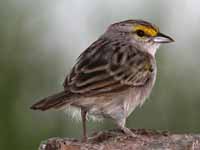



Genus Ammospiza
Three out of four of these species are coastal birds that frequent tidal marshes. The Le Conte's sparrow is an inland bird that prefers grasslands.
Sparrow,_Le_Conte's Ammospiza leconteii
Description: The Le Conte's sparrow has a brownish and beige streaked back. It has a dark crown with white median stripe and a buffy yellow-orange face with grey cheeks. The neck is lilac-grey with chestnut streaks. It has an orange yellow breast and flanks with dark brown streaks, a grey bill, and brownish-pink legs. The Le Conte's sparrow is up to 13 cm long. The similar Henslow's sparrow has an olive neck.
Range: The middle of North America.
Habitat: Grassy areas with vegetation cover. It is thus hard to observe.
Diet: Mianly seeds in the winter and insects in the summer.
Conservation status: Least Concern.
Image by: 1) Ken_Schneider - California 2) Laura Erickson 3) Sonny Cohen - Illinois 4) Tom_Benson - California Range: The middle of North America.
Habitat: Grassy areas with vegetation cover. It is thus hard to observe.
Diet: Mianly seeds in the winter and insects in the summer.
Conservation status: Least Concern.



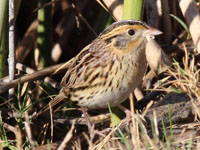
Sparrow,_Nelson's Ammospiza nelsoni
Description: The Nelson's sparrow has brownish upperparts with grey on the crown and nape. It has an orange face with grey cheeks, white throat, and a short pointed tail. The breast is cream-colored breast with light or indistinct streaking; the belly is white. The similar saltmarsh sparrow. has distinct stripes on its breast. The savannah sparrow has a white crown stripe and the seaside sparrow has yellow in front of the eye.
Range: Eastern half of North America.
Habitat: Grasslands, coastal marshes.
Diet: Mainly seeds in the winter and insects otherwise.
Conservation status: Least Concern.
Image by: 1, 2) Wildreturn - Missouri 3, 4) Jerry Oldenettel - Texas Range: Eastern half of North America.
Habitat: Grasslands, coastal marshes.
Diet: Mainly seeds in the winter and insects otherwise.
Conservation status: Least Concern.

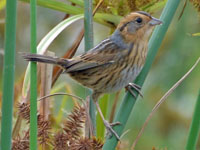


Sparrow,_Saltmarsh Ammospiza caudacuta
Description: The saltmarsh sparrow has brownish upperparts with grey on the crown and nape. It has an orange face with grey cheeks, white throat, and a short pointed tail. The breast is cream-colored breast with distinct streaking; the belly is white. The saltmarsh sparrow is about 13 cm long. The similar Nelson's sparrow has blurry stripes on breast. The Savannah sparrow has a white crown stripe. The seaside sparrow has yellow in front of its eye.
Range: East coast of North America.
Habitat: Coastal marshes.
Diet: Seeds, insects, snails.
Conservation status: Least Concern.
Image by: 1) Mark Tillett - Maryland 2) Wolfgang Wander - New York 3) Bob Devlin - New York 4) Tom_Wilberding - MaineRange: East coast of North America.
Habitat: Coastal marshes.
Diet: Seeds, insects, snails.
Conservation status: Least Concern.

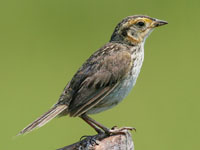
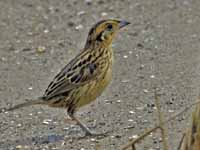

Sparrow,_Seaside Ammospiza maritima
Description: The seaside sparrow has brownish upperparts with grey on the crown and nape. It has a dark face with grey cheeks and a white throat. There is a small yellow streak just above the eye. Its greyish buff colored breast has dark dark streaks; the belly is whitish. The seaside sparrow is up to 15 cm long. The similar Nelson's sparrow and saltmarsh sparrow.do not have yellow in front of the eyes. The Savannah sparrow has a white crown stripe.
Range: East and Gulf coasts of North America.
Habitat: Saltmarshes with tall grass.
Diet: Insects, marine invertebrates, seeds.
Conservation status: Least Concern.
Image by: 1) Jeff and Amy 2) Jeff Whitlock - Texas 3) Dick Daniels - North Carolina 4) P. W. Sykes, USFWS Range: East and Gulf coasts of North America.
Habitat: Saltmarshes with tall grass.
Diet: Insects, marine invertebrates, seeds.
Conservation status: Least Concern.
4) Dusky Seaside sparrow Ammospiza m. nigrescens. Now extinct.




Genus Amphispiza
Sparrow,_Black-throated Amphispiza bilineata
Description: The black-throated sparrow has grey-brown upperparts. It has a wide white supercilium with a black border above. It has black lores and a black throat. The underparts are white. Its unique plumage makes it easy to identify.
Range: Southwestern USA and Mexico.
Habitat: Desert hillsides and scrub.
Diet: Seeds and insects.
Conservation status: Least Concern.
Image by: 1) Alan D. Wilson - Borrego Springs, California 2) Elaine R Wilson - Borrego Springs, California 3) Charlie Westerinen - "Hole in the Wall ", Utah 4) Kevin ColeRange: Southwestern USA and Mexico.
Habitat: Desert hillsides and scrub.
Diet: Seeds and insects.
Conservation status: Least Concern.

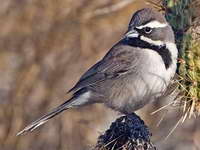
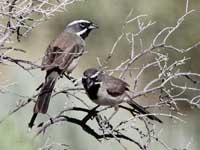

Genus Amphispizopsis
Sparrow,_Five-striped Amphispizopsis quinquestriata
Description: The five-striped sparrow has brownish upperparts. It five stripes are: 2 white superciliums, 2 white malar stripes, and a black throat. Or counted another way, there is sometimes a white medium strip on the throat. In that case the throat stripes are: white malar, black stripe, white center of throat, black stripe, white malar. The breast and flanks are grey with a black breast-spot. The belly is white. The five-striped sparrow is up to 15 cm long.
Range: Southern Arizona, Mexico.
Habitat: Dry hillsides.
Diet: Seeds and insects, especially caterpillars. It usually hops on the ground instead of walking.
Conservation status: Least Concern.
Image by: 1) Marcel Holyoak - Arizona 2) Dominic Sherony - Mexico 3) Don_Faulkner - Arizona 4) Bettina_Arrigoni - ArizonaRange: Southern Arizona, Mexico.
Habitat: Dry hillsides.
Diet: Seeds and insects, especially caterpillars. It usually hops on the ground instead of walking.
Conservation status: Least Concern.


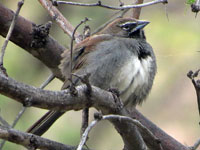

Genus Arremon
Some of these species are termed sparrows and some are termed brush-finches. They are from 15 to 21 cm long, with the brush-finches generally longer than those called sparos. These sparrow-like birds are found mostly in South America and some in Central America. They usually have olive upperparts, a mostly black head, and a white throat. Genus Atlapetes contains the true brush-finches.
Finch, Black-headed Brush- Arremon atricapillus
Description: The black-headed brush-finch has an olive mantle. The head is black with a white throat. The underparts are also white except for grey flanks. The black-headed brush-finch is 19 cm long.
Range: Mainly Columbia; also Panama.
Habitat: Moist forests with dense undergrowth.
Diet: Insects and seeds which it gathers on the ground.
Conservation status: Least Concern.
Image by:
1) Felix_Uribe - ColumbiaRange: Mainly Columbia; also Panama.
Habitat: Moist forests with dense undergrowth.
Diet: Insects and seeds which it gathers on the ground.
Conservation status: Least Concern.

Finch, Chestnut-capped Brush- Arremon brunneinucha
Description: The chestnut-capped brush-finch has olive upperparts. It has a chestnut crown plus nape, a black mask, black sides of the head, and white spots on each side of the forehead. There may be a black breast-band or it may be absent. It has a white throat, grey flanks, white center-breast, and white belly. The chestnut-capped brush-finch is up to 20 cm long.
Range: Mexico to southeastern Peru.
Habitat: Moist forests with undergrowth.
Diet: Seeds, insects, and spiders which are found on the ground.
Conservation status: Least Concern.
Image by:
1) Charles Sharp - Costa Rica 2) Amy McAndrews - Mexico 3) Nick Athanas - Mexico 4) Cephas - Costa RicaRange: Mexico to southeastern Peru.
Habitat: Moist forests with undergrowth.
Diet: Seeds, insects, and spiders which are found on the ground.
Conservation status: Least Concern.


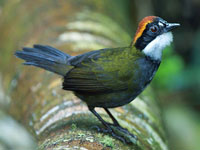

Finch, Costa Rican Brush- Arremon costaricensis
Description: The Costa-Rican brush-finch has olive upperparts with a grey tail. It has a black crown, black nape, a large black eye-patch, and a grey supercilium that extends to the neck. The underparts are white with grey flanks. The Costa-Rican brush-finch is up to 20 cm long.
Range: Panama, Costa Rica.
Habitat: Undergrowth of humid forest; especially near the edges.
Diet: Seeds, insects, spiders.
Conservation status: Least Concern.
Image by: 1) Nick_Athans - PanamaRange: Panama, Costa Rica.
Habitat: Undergrowth of humid forest; especially near the edges.
Diet: Seeds, insects, spiders.
Conservation status: Least Concern.

Finch,_Grey-browed_Brush- Arremon assimilis
Description: The grey-browed brush-finch has olive upperparts including the wings and tail. It has a black cap with a grey median stripe and a black face with a broad grey supercilium. It has a white throat, white breast with grey sides, and white belly with grey flanks. The grey-browed brush-finch is up to 20 cm long.
Range: Andes of Columbia, Ecuador, Peru, Venezuela.
Habitat: Undergrowth of humid forest; especially near the edges.
Diet: Probably Seeds, insects, spiders.
Conservation status: Least Concern.
Image by: 1. 2) Nick Athanas - Ecuador, Columbia 3) Brendan_Ryan - ColumbiaRange: Andes of Columbia, Ecuador, Peru, Venezuela.
Habitat: Undergrowth of humid forest; especially near the edges.
Diet: Probably Seeds, insects, spiders.
Conservation status: Least Concern.
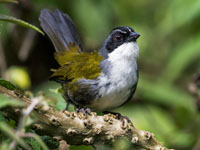

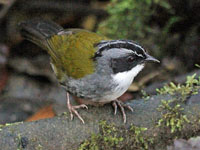
Finch,_Green-striped Brush- Arremon virenticeps
Description: The green-striped brush-finch has olive upperparts. It has black median crown stripe , a bold green supercilium stripe, and a black mask. Sometimes the green stripe is hard to see. The throat is white, the breast plus flanks grey, and the belly is white. The green-striped brush-finch is up to 21 cm long.
Range: Mexico.
Habitat: Moist montane forests.
Diet: Probably Seeds, insects, spiders.
Conservation status: Least Concern.
Image by: 1) Dominic Sherony 2) Francesco_VeronesiRange: Mexico.
Habitat: Moist montane forests.
Diet: Probably Seeds, insects, spiders.
Conservation status: Least Concern.


Finch, Olive Arremon castaneiceps
Description: The olive finch has mainly olive-green plumage. It has a chestnut crown plus nape, dark grey face and throat. The olive finch is up to 17 cm long.
Range: Andes of Columbia. Ecuador, and northern Peru.
Habitat: Moist montane forests.
Diet: Probably Seeds, insects, spiders.
Conservation status: It is listed as Near Threatened because of some decline in the population.
Image by: 1) Francesco_Veronesi - Columbia 2) Nick Athanas - Ecuador 3) Ana_Agreda - EcuadorRange: Andes of Columbia. Ecuador, and northern Peru.
Habitat: Moist montane forests.
Diet: Probably Seeds, insects, spiders.
Conservation status: It is listed as Near Threatened because of some decline in the population.
1) Juvenile

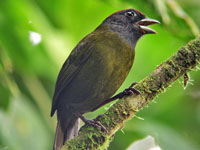

Finch, Perija Brush- Arremon perijanus
Description: The Perila brush-finch has olive upperparts, It has a black cap with grey median stripe, black mask , and grey supercilium. The throat is white and usually bordered below by black. It has white underparts. The Perila brush-finch is about 19 cm long.
Range: The Perija Mountains of Columbia, northwest Venezuela.
Habitat: Undergrowth of humid montane forests.
Diet: Probably seeds, insects, spiders.
Conservation status: It is listed as Vulnerable because of its small range and habitat degradation. That said, the bird is difficult to observe so its population size is not well known.
Image by: 1, 2, 3) Andres Cuervo - ColumbiaRange: The Perija Mountains of Columbia, northwest Venezuela.
Habitat: Undergrowth of humid montane forests.
Diet: Probably seeds, insects, spiders.
Conservation status: It is listed as Vulnerable because of its small range and habitat degradation. That said, the bird is difficult to observe so its population size is not well known.



Finch, Sierra Nevada Brush- Arremon basilicus
Description: The Sierra Nevada brush-finch has olive green upperparts. It has a black head with whitish-grey supercilium and median crown stripe. The white throat is bordered by a black collar. It has grey underparts and a black bill. The Sierra Nevada brush-finch is up to 19 cm long.
Range: The Sierra Nevada de Santa Marta of northern Columbia.
Habitat: Undergrowth of humid forests; especially forest edges.
Diet: Probably Seeds, insects, spiders.
Conservation status: It is listed as Near Threatened because of its small range.
Image by: 1) thibaudaronson 2) Nick AthanasRange: The Sierra Nevada de Santa Marta of northern Columbia.
Habitat: Undergrowth of humid forests; especially forest edges.
Diet: Probably Seeds, insects, spiders.
Conservation status: It is listed as Near Threatened because of its small range.
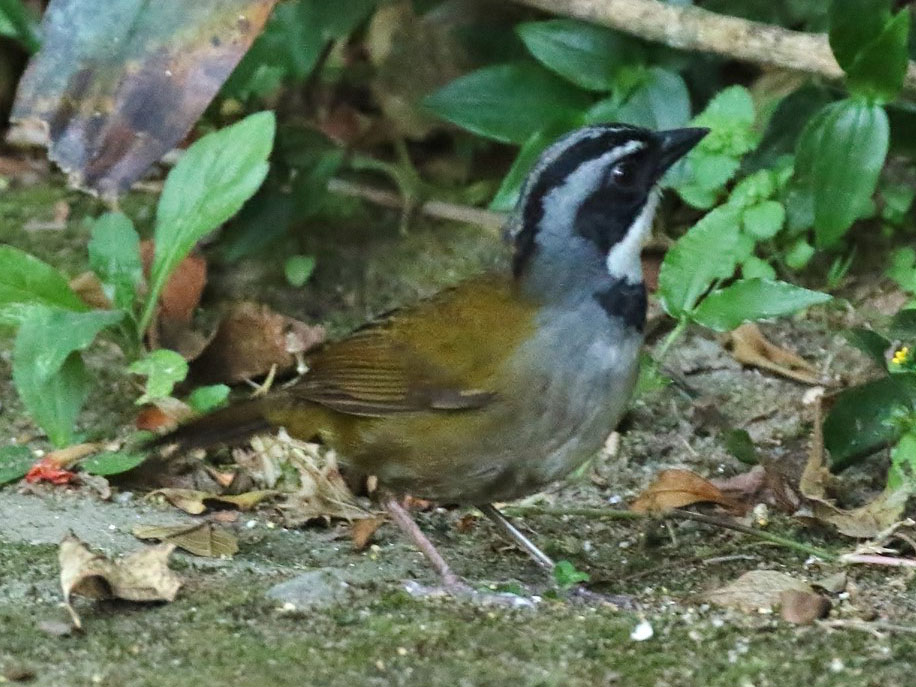

Finch, Sooty-faced Arremon crassirostris
Description: The sooty-faced finch has olive-green upperparts with the wings and tail browner. It has a dark rusty crown, dark grey face, dark grey throat, and whitish malar stripe. It has a green breast, green flanks, and a yellow-green belly. The sooty-faced finch is up to 17 cm long.
Range: Colombia, Costa Rica, Panama.
Habitat: Dense humid forests and undergrowth.
Diet: Insects, spiders; also berries.
Conservation status: Least Concern.
Image by:
1, 2) Nick Athanas - Costa RicaRange: Colombia, Costa Rica, Panama.
Habitat: Dense humid forests and undergrowth.
Diet: Insects, spiders; also berries.
Conservation status: Least Concern.


Finch,_White-browed_Brush- Arremon torquatus
Description: The white-browed brush-finch, also known as the stripe-headed brush-finch, has olive-green upperparts. It has a black head with a white supercilium extending along the nape. The throat is white as are usually the underparts, but some subspecies have a black breast-band.
Range: Argentina, Bolivia, Peru.
Habitat: Montane forests and dense second growth.
Diet: Insects, spiders, seeds, fruit.
Conservation status: Least Concern.
Image by:
1) Giselle_Mangini 2) Nick Athanas - Argentina 3) Francesco_VeronesiRange: Argentina, Bolivia, Peru.
Habitat: Montane forests and dense second growth.
Diet: Insects, spiders, seeds, fruit.
Conservation status: Least Concern.



Sparrow,_Black-capped Arremon abeillei
Description: The black-capped sparrow has grey upperparts in some subspecies, but has a green mantle in subspecies A. a. nigriceps. It has a black cap, forehead, and mask. There is a wide white supercilium, white throat, narrow black breast band, grey flanks, and a whitish belly. The black-capped sparrow is 15 cm long.
Range: Western Ecuador, Peru.
Habitat: Forests and dense second growth.
Diet: Probably insects, spiders, seeds, fruit.
Conservation status: Least Concern.
Image by: 1) Francesco Veronesi - Ecuador 2) Nick Athanas - EcuadorRange: Western Ecuador, Peru.
Habitat: Forests and dense second growth.
Diet: Probably insects, spiders, seeds, fruit.
Conservation status: Least Concern.

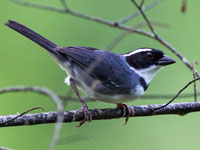
Sparrow,_Golden-winged Arremon schlegeli
Description: The golden-winged sparrow has greyish upperparts with a greenish patch on the back merging with greenish-golden wings. It has a golden bill, black head, black half collar, and white throat. The underparts are whitish with grey flanks. A subspecies lacks the greenish patch on back. The golden-winged sparrow is about 16 cm long.
Range: Caribbean coasts of Columbia, Venezuela.
Habitat: Dry tropical forests and shrublands.
Diet: Insects, spiders, seeds, fruit.
Conservation status: Least Concern.
Image by: 1) Arley_Vargas 2, 3) Nick Athanas - Columbia 4) Bryant_OlsenRange: Caribbean coasts of Columbia, Venezuela.
Habitat: Dry tropical forests and shrublands.
Diet: Insects, spiders, seeds, fruit.
Conservation status: Least Concern.




Sparrow,_Half-collared Arremon semitorquatus
Description: The half-collared sparrow has olive-green upperparts. It has a black head with white supercilium and a narrow white median crown stripe. The underparts are white with a black half-collar. The upper-bill is black and the lower is yellow. The similar Sao Francisco sparrow has an all yellow bill and a narrower half-collar. The half-collared sparrow is 15 cm long.
Range: Southeastern Brazil.
Habitat: Moist lowland forest and heavily degraded former forest.
Diet: Probably insects, spiders, seeds, fruit.
Conservation status: Least Concern.
Image by: 1) Dario Sanches - Brazil 2) Claudio Timm - Brazil 3) Nick Athanas 4) Carlos_HenriqueRange: Southeastern Brazil.
Habitat: Moist lowland forest and heavily degraded former forest.
Diet: Probably insects, spiders, seeds, fruit.
Conservation status: Least Concern.

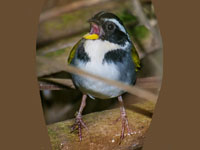


Sparrow,_Orange-billed Arremon aurantiirostris .
Description: The orange-billed sparrow has olive-green upperparts with darker wings and tail. It has an orange bill, yellow-brown nape, and yellow shoulders. The head is black with a white superciliium and narrow white median crown stripe. The throat is white as are the underparts with a black breast band.
Range: Central America, Columbia, Ecuador, Peru.
Habitat: Woodland undergrowth.
Diet: Insects, spiders, seeds, fruit.
Conservation status: Least Concern.
Image by: 1) Dominic Sherony 2) Joule_e 3) Nick Athanas - Ecuador 4) Francesco_Veronesi - EcuadorRange: Central America, Columbia, Ecuador, Peru.
Habitat: Woodland undergrowth.
Diet: Insects, spiders, seeds, fruit.
Conservation status: Least Concern.




Sparrow,_Pectoral Arremon taciturnus
Description: The pectoral sparrow has green upperparts. It has a black bill, black face, white supercilium, white median crown stripe, and white underparts. The pectoral sparrow is up to 15 cm long.
Range: Amazon basin of South America.
Habitat: Moist lowland forests.
Diet: Insects, spiders, seeds. Probably fruit.
Conservation status: Least Concern.
Image by: 1, 2) Hector_Bottai - Brazil 3) Claudio_TimmRange: Amazon basin of South America.
Habitat: Moist lowland forests.
Diet: Insects, spiders, seeds. Probably fruit.
Conservation status: Least Concern.



Sparrow,_Saffron-billed Arremon flavirostris
Description: The saffron-billed sparrow has grey or olive upperparts, depending on the subspecies, with yellow shoulders. There is a black cap, black mask, and a white supercilium that starts above the eye and approaches the nape. The bill is orange-yellow thus its name. It has white underparts with a black breast band and grey flanks. The saffrron-billed sparrow is up to 17 cm long.
Range: Argentina, Bolivia, Brazil, and Paraguay.
Habitat: Woodland undergrowth.
Diet: Insects, spiders, seeds, fruits.
Conservation status: Least Concern.
Image by: 1, 2)
Dario Sanches - Brazil 3) Nick Athanas - BrazilRange: Argentina, Bolivia, Brazil, and Paraguay.
Habitat: Woodland undergrowth.
Diet: Insects, spiders, seeds, fruits.
Conservation status: Least Concern.
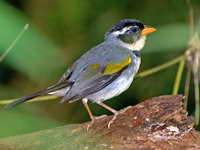


Sparrow,_Sao Francisco Arremon franciscanus
Description: The Sao Francisco sparrow has olive-green upperparts. It has a black head with white supercilium and narrow white median crown stripe. The bill is yellow. The throat is white with a narrow black half-collar. The similar half-collared sparrow has a wider "half-collar" and a black upper-bill and yellow lower-bill. The Sao Francisco sparrow is 15 cm long.
Range: Valley of Sao Francisc in Brazil.
Habitat: The Caatinga which is a shrub and thorny forest of Brazil.
Diet: Probably Insects, spiders, seeds, fruits.
Conservation status: It is listed as Near Threatened due to its small range and habit loss.
Image by: 1) Nick Athanas - BrazilRange: Valley of Sao Francisc in Brazil.
Habitat: The Caatinga which is a shrub and thorny forest of Brazil.
Diet: Probably Insects, spiders, seeds, fruits.
Conservation status: It is listed as Near Threatened due to its small range and habit loss.

Genus Arremonops
All species are found in Central America, Mexico, and/or northern South America. The Olive sparrow reaches southern Texas.
Sparrow,_Black-striped Arremonops conirostris
Description: The black-striped sparrow has olive upperparts. It has a grey head, broad black stripes on each side of crown, and black eye-lines. The off-white underparts shade to olive on lower belly; the flanks are pale grey. The female builds a large domed nest and only she incubates the eggs. The black-striped sparrow is up to 17 cm long. The similar Tocuyo sparrow is slightly smaller than the black-striped sparrow and slightly paler. They principally segregate by habitat, with the black-striped inhabiting more humid areas in their zone of overlap.
Range: Guatemala south to northen South America.
Habitat: Forest edges, undergrowth, dense shrubs.
Diet: Mainly insects, especially grasshoppers. Also seeds, berries.
Conservation status: Least Concern.
Image by: 1, 2) Nathan Rupert - San Diego Zoo 3) Dick Daniels - Boquette, Panama 4) Nick Athanas - Costa RicaRange: Guatemala south to northen South America.
Habitat: Forest edges, undergrowth, dense shrubs.
Diet: Mainly insects, especially grasshoppers. Also seeds, berries.
Conservation status: Least Concern.




Sparrow,_Green-backed Arremonops chloronotus
Description: The green-backed sparrow has bright green upperparts. It has a grey head with black stripes. The underparts are also grey. The green-backed sparrow is up ot 16 cm long. It was formerly a subspecies of the black-striped sparrow. They only overlap in Honduras. The green-backed has a faint white arc above and below the eye. The similar olive sparrow has brown head stripes while the green-backed has grey head stripes.
Range: Mainly Belize. Also bordering countries: southeastern Mexico, northern Guatemala, western Honduras .
Habitat: Forest undergrowth.
Diet: Probably insects, seeds, berries.
Conservation status: Least Concern.
Image by: 1, 2) Dominic Sherony - Belize 3) Amy McAndrews - MexicoRange: Mainly Belize. Also bordering countries: southeastern Mexico, northern Guatemala, western Honduras .
Habitat: Forest undergrowth.
Diet: Probably insects, seeds, berries.
Conservation status: Least Concern.
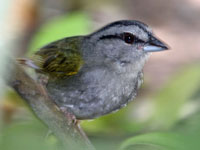


Sparrow,_Olive Arremonops rufivirgatus
Description: The olive sparrow has olive upperparts. The head is grey with a prominent brown eye streak and stripes on the crown. It has a buffy breast, some white belly feathers, and a conical bill.
Range: Southern Texas, northern Central America.
Habitat: Dense undergrowth; shy and difficult to observe.
Diet: Probably insects, seeds.
Conservation status: Least Concern.
Image by: 1) Alan D. Wilson - Ramirez Ranch, Near Roma, Texas 2) Bill Bouton - Texas 3) Jerry Oldenettel - Texas 4) naturespicsonline.comRange: Southern Texas, northern Central America.
Habitat: Dense undergrowth; shy and difficult to observe.
Diet: Probably insects, seeds.
Conservation status: Least Concern.
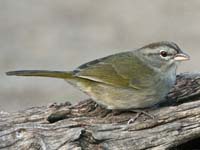



|
Sparrow,_Tocuyo Arremonops tocuyensis
Description: The Tocuyo sparrow has olive upperparts. It has a grey head, broad black stripes on each side of its crown, and black eye-stripes. The underparts are off-white shading to olive on the lower belly and the flanks are pale grey. The name comes from a town in Venezuela which is one of the places it inhabits. The Tocuyo sparrow is up to 14 cm long. The similar black-striped sparrow segregates by habitat, with the black-striped inhabiting more humid areas in their zone of overlap.
Range: Columbia, Venezuela
Habitat: Scrubby areas and patches of low-stature deciduous woodland,.
Diet: Unknown.
Conservation status: Least Concern.
Image by: 1) Zieger_M 2, 3) Nick Athanas - ColumbiaRange: Columbia, Venezuela
Habitat: Scrubby areas and patches of low-stature deciduous woodland,.
Diet: Unknown.
Conservation status: Least Concern.


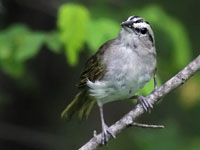
Genus Artemisiospiza
Sparrow,_Bell's Artemisiospiza belli
Description: The Bell's sparrow has a buffy-brown back with muted stripes. It has a grey-brown head, white eye-ring, white throat, and white moustacial stripe. The underparts are white with a dark spot on the breast. The Bell's sparrow is about 15 cm long. The sagebrush sparrow is very similar. Bell's mantle is plainer.
Range: Southwestern United States, northwestern Mexico.
Habitat: Arid locations with sagebrush and other low shrubs.
Diet: Seeds, insects, spiders, berries.
Conservation status: Least Concern.
Image by: 1, 2) Tom Benson 3) Bill Bouton 4) Becky_Matsubara - CaliforniaRange: Southwestern United States, northwestern Mexico.
Habitat: Arid locations with sagebrush and other low shrubs.
Diet: Seeds, insects, spiders, berries.
Conservation status: Least Concern.
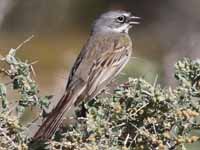

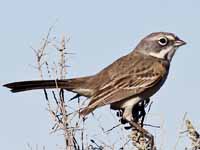
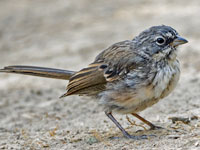
Sparrow,_Sagebrush Artemisiospiza nevadensis
Description: The sagebrush sparrow has a buffy-brown back with muted stripes. It has a grey-brown head, white eye-ring, white throat, and white moustacial stripe. The underparts are white with a dark spot on the breast.
Range: Southwest desert in USA.
Habitat: Arid locations with sagebrush and other low shrubs.
Diet: Seeds, insects, spiders, berries.
Conservation status: Least Concern.
Image by: 1. 2) Jamie Chevez 3) Dominic Sherony 4) Charlie Westerinen - NevadaRange: Southwest desert in USA.
Habitat: Arid locations with sagebrush and other low shrubs.
Diet: Seeds, insects, spiders, berries.
Conservation status: Least Concern.




Genus Centronyx
Sparrow,_Baird's Centronyx bairdii
Description: The Baird's sparrow has brown upperparts with dark streaks. It has a yellowish face, nape, and an ochre crown stripe. The head appears flat and it has a pale large bill. It has
whitish underparts; with some brown streaks on its breast and flanks. The Baird's sparrow is about 12 cm long. The similar grasshopper sparrow has a plain breast. The Savannah sparrow has more streaking.
Range: Breeds in north-central US and southern Canada. Year round in northern Mexico and adjacent Arizona plus New Mexico.
Habitat: Grasslands.
Diet: Seeds and insects which it forages while on the ground.
Conservation status: Least Concern, but the population is declinging due to reduction of grasslands.
Image by: 1) Dominic Sherony 2)Tom_Benson - North Dakota 3) Rick Bohn 4) Nicholas_Pederson - New MexicoRange: Breeds in north-central US and southern Canada. Year round in northern Mexico and adjacent Arizona plus New Mexico.
Habitat: Grasslands.
Diet: Seeds and insects which it forages while on the ground.
Conservation status: Least Concern, but the population is declinging due to reduction of grasslands.




Sparrow,_Henslow's Centronyx henslowii
Description: The Henslow's sparrow has streaked brown upperparts with rust-colored wings. It has a dark crown with white median stripe, an olive face, olive neck, and a whitish throat. The breast is streaked light brown and the belly is whitish belly. neck. It has a short dark forked tail. The similar Le Conte's sparrow has a lilac-grey neck.
Range: Eastern half of North America.
Habitat: Grasslands with little or now shrubs.
Diet: Seeds, insects, berries all of which are foraged on the ground.
Conservation status: Least Concern.
Image by: 1) Dominic Sherony 2) Janet and Phil - Illinois 3, 4) Ken Schneider Range: Eastern half of North America.
Habitat: Grasslands with little or now shrubs.
Diet: Seeds, insects, berries all of which are foraged on the ground.
Conservation status: Least Concern.


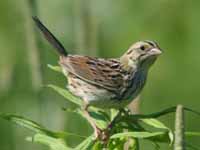

Genus Chlorospingus
The members of this genus were previously placed in the tanager family Thraupidae. Their closed relatives are the species in genus Arremonops. The chlorospingus eat insects, spiders, small fruits, and berries. Even though they are in the Passerellidae family they do not eat seeds, as evidenced by their thinner bill as other family members such as the sparrows. There are usually found in small flock which may be mixed with other species.
Chlorospingus,_Ashy-throated Chlorospingus canigularis
Description: The ashy-throated chlorospingus, also known as the ashy-throated bush-tanager, has pale green upperparts. It has a grey head, paler grey throat, yellow breast-band, greenish-yellow flanks, and a whitish belly. The ashy-throated chlorospingus is about 14 cm long.
Range: Western South America.
Habitat: Humid forests favoring areas with moss and vines.
Diet: Probably berries and fruits. Forages in canopy, especially where there are vines.
Conservation status: Least Concern.
Image by: 1, 2) Alejandro Tamayo 3) Ana Agreda 4) Nick Athanas - EcuadorRange: Western South America.
Habitat: Humid forests favoring areas with moss and vines.
Diet: Probably berries and fruits. Forages in canopy, especially where there are vines.
Conservation status: Least Concern.




Chlorospingus,_Common Chlorospingus flavopectus
Description: The common chlorospingus, also known as common bush-tanager, has olive upperparts. It has a brown head or grey head depending on the subspecies. There is a white spot behind the eye; light throat. The throat is pale. the underparts yellow and becoming white on the belly. There is a large variation in the subspecies and some will probably eventually be specified as separate species. They all have a common feature of the white eye spot. The common chlorospingus is about 14 cm long.
Range: Mexico to western South America.
Habitat: Humid woodlands, clearings, and areas near trees.
Diet: Insects, spiders, fruits, nectar.
Conservation status: Least Concern.
Image by: 1) Andres Cuervo 2 - 5) Nick Athanas - Argentina, Costa Rica, Guatemala, MexicoRange: Mexico to western South America.
Habitat: Humid woodlands, clearings, and areas near trees.
Diet: Insects, spiders, fruits, nectar.
Conservation status: Least Concern.
2) C. f. argentinus (southernmost subspecies) 3) C. f. regionalis (s. Mexico to Panama) 4) C. f. postocularis (w. Guatelama and nearby Mexico) 5) C. f. wetmorei (Mexico)
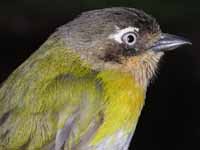



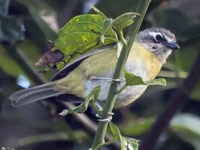
Chlorospingus,_Dusky Chlorospingus semifuscus
Description: The dusky chlorospingus, also known as the dusky bush-tanager, has olive upperparts. It has a dark greyish head and neck. The underparts are pale brownish-grey and some subspecies have yellowish flanks.
Range: Western Columbia and Ecuador.
Habitat: Moist montane forests.
Diet: Insects, spiders, fruits, berries; forages in trees.
Conservation status: Least Concern.
Image by: 1) Sergey Pisarevskiy 2) Don Faulkner - Ecuador 3) Nick Arthanas - Ecuador 4) Francesco_VeronesiRange: Western Columbia and Ecuador.
Habitat: Moist montane forests.
Diet: Insects, spiders, fruits, berries; forages in trees.
Conservation status: Least Concern.



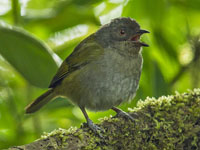
Chlorospingus, Pirre also Chlorospingus inornatus
Description: The Pirre chlorospingus, also known as the Pirre bush-tanager, has olive green upperparts. It has a blackish crown and forehead. The eyes are pale but bold. It has dirty yellow underparts. The Pirre chlorospingus is about 15 cm long.
Range: Panama. This species is named after Cerro Pirre, a mountain in Panama.
Habitat: Forest edges and canopy; prefers areas with vines.
Diet: Insects, spiders, fruits, berries.
Conservation status: Least Concern.
Image by: 1) Stewart BentleyRange: Panama. This species is named after Cerro Pirre, a mountain in Panama.
Habitat: Forest edges and canopy; prefers areas with vines.
Diet: Insects, spiders, fruits, berries.
Conservation status: Least Concern.

Chlorospingus, Short-billed Chlorospingus parvirostris
Description: The short-billed chlorospingus, also known as the yellow-whiskered bush-tanager, has olive upperparts, including much of its head. The sides of its throat are yellow, which leads to its yellow-whiskered name, which is probably more appropriate than short-billed as its bill is not noticeably short. The eyes are pale and underparts are greyish. The yellow-whiskered bush-tanager is about 14 cm long.
Range: Bolivia, Colombia, Ecuador, and Peru.
Habitat: Moist montane forests.
Diet: Insects, spiders, fruits, berries.
Conservation status: Least Concern.
Image by: 1) Tony_Castro - EcuadorRange: Bolivia, Colombia, Ecuador, and Peru.
Habitat: Moist montane forests.
Diet: Insects, spiders, fruits, berries.
Conservation status: Least Concern.

Chlorospingus, Sooty-capped Chlorospingus pileatus
Description: The sooty-capped chlorospingus, also known as the sooty-capped bush-tanager, has olive upperparts. It has a mainly black head, bold white supercilium, and a grey throat. The underparts are yellow becoming whiter on the belly. The sooty-capped chlorospingus is about 14 cm long.
Range: Costa Rica, Panama.
Habitat: Montane woodlands.
Diet: Insects, spiders, fruits.
Conservation status: Least Concern.
Image by: 1) Jerry Oldenettel - Costa Rica 2) Carol Foil - Costa Rica 3) Kathy and Sam - Costa Rica 4) Nick Athanas - Costa RicaRange: Costa Rica, Panama.
Habitat: Montane woodlands.
Diet: Insects, spiders, fruits.
Conservation status: Least Concern.




Chlorospingus,_Tacarcuna Chlorospingus tacarcunae
Description: The Tacarcuna chlorospingus, also known as the Tacarcuna brush-tanager, takes it name from Cerro Tacarcuna which is a mountain in Panama, It has mainly olive upperparts, including the head. The eyes are pale. It has a yellow neck, yellow breast, and grey belly.
Range: Mainly Panama; also northwest Columbia.
Habitat: Moist montane forests.
Diet: Probably insects, spiders, fruits.
Conservation status: Least Concern.
Range: Mainly Panama; also northwest Columbia.
Habitat: Moist montane forests.
Diet: Probably insects, spiders, fruits.
Conservation status: Least Concern.
Chlorospingus,_Yellow-throated Chlorospingus flavigularis
Description: The yellow-throated chlorospingus, also known as the yellow-throated bush-tanager, has olive upperparts. It has grey lores and a yellow throat. The underparts are also grey. The yellow-throated chlorospingus is about 13 cm long.
Range: Western South America.
Habitat: Moist montane woodlands.
Diet: Insects, spiders, fruits.
Conservation status: Least Concern.
Image by: 1) Aves_y_Conservacion 2) David Cook - Ecuador 3) Nick Athanas - Ecuador 4) Jerry Oldenettel - EcuadorRange: Western South America.
Habitat: Moist montane woodlands.
Diet: Insects, spiders, fruits.
Conservation status: Least Concern.




Genus Chondestes - 1 species
Sparrow,_Lark Chondestes grammacus
Description: Lark sparrow is distinctive. Adults have a typically sparrow-like dark-streaked brown back, and white underparts except for a dark central spot. The cheeks and crown sides are chestnut, with white eyebrow and crown stripes. The dark tail's corners are also white. The male's breeding ritual is similar to that of a turkey: tail up and wings dragging on the ground. Lark sparrow is up to 17 cm long.
Range: North America.
Habitat: Edge habitats between grasslands and forests.
Diet: Seeds and insects which it finds while on the ground.
Conservation status: Least Concern.
Image by: 1) Alan D. Wilson - Arizona 2) Len Blumin - California 3) Kat and Sam - Oregon 5) Teddy LlovetRange: North America.
Habitat: Edge habitats between grasslands and forests.
Diet: Seeds and insects which it finds while on the ground.
Conservation status: Least Concern.

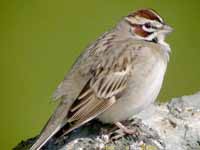


Genus Melospiza
These are medium-sized sparrows with long tails, which are pumped in flight and held moderately high on perching. They occurs as a few individuals or solitary. They prefer brushy habitats, often near water.
Sparrow,_Lincoln's Melospiza lincolnii
Description: The Lincoln's sparrow has olive-brown upperparts with dark streaks. It has a thin grey median crown stripe, brown eye-line, and brown eye-ring. The breast has narrow brown streaks and the belly is white. Some have a dark breast spot. The Lincoln's sparrow is up to 15 cm long. The similar song sparrow is much more bold and easier to find. Lincoln's has finer breast streaks.
Range: North America.
Habitat: Dense ground cover, especially near willows in wet areas.
Diet: Seeds, insects, insect larvae, spiders.
Conservation status: Least Concern.
Image by: 1) Ed Gaillard - New York City
2) Kelly Colgan Azar 3) Bill Bouton - California 4) Becky_Matsubara - CaliforniaRange: North America.
Habitat: Dense ground cover, especially near willows in wet areas.
Diet: Seeds, insects, insect larvae, spiders.
Conservation status: Least Concern.
1) Juvenile




Sparrow,_Song Melospiza melodia
Description: The song sparrow is very varied with approximately 30 subspecies. It has brown upperparts with dark streaks. The face, eye-line, and eye-ring are grey. The underparts are white with thick dark streaks on the breast and some have a dark breast spot. They are named for the male's melodious singing which they often perform while conspicuously perched. The song sparrow ranges up to 18 cm in length. The similar Lincoln's sparrow has a shorted tail and is much more shy than a song sparrow.
Range: North America.
Habitat: Brushlands, marshes, and many other environments.
Diet: Seeds, insects, insect larvae, spiders.
Conservation status: Least Concern.
Image by: 1) Ingrid Taylar - California 2) Ken Schneider - Illinois 3) Eugene Beckes 4) Dick Daniels - North Carolina 5) Dick - Maine 6) Dick - CaliforniaRange: North America.
Habitat: Brushlands, marshes, and many other environments.
Diet: Seeds, insects, insect larvae, spiders.
Conservation status: Least Concern.

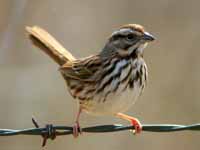




Sparrow,_Swamp Melospiza georgiana
Description: Swamp Sparrrow have streaked rusty, buff and black upperparts with a grey breast, light belly and a white throat. The wings are strikingly rusty. Most males and a few females have a rust-colored caps. Their face is grey with a dark line through the eye. They have a short bill and fairly long legs.
Range: Most of North America, but not west of the Rockies.
Habitat: Near water.
Diet: Seeds, insects, insect larvae, spiders.
Conservation status: Least Concern.
Image by:1) Dick Daniels - the Washington National Zoo 2) Keenan Adams, USFWS 3) Dick - McGee Island, Maine
4) Ken Schneider - Illinios Range: Most of North America, but not west of the Rockies.
Habitat: Near water.
Diet: Seeds, insects, insect larvae, spiders.
Conservation status: Least Concern.

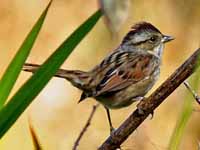


Sparrow,_Coastal Plain Swamp Melospiza georgiana nigrescens
Description: The coastal plain swamp sparrow is a subspecies of the swamp sparrow. Its winter range is from southern Virginia to South Carolina
Image by: 1) Dick Daniels - the Washington National Zoo 2) Pauls95BlazerThis is a subspecies of the Swamp sparrow that lives in saltwater marshes along the milddle Atlantic states.
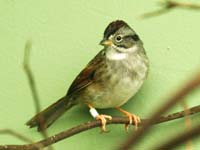

Genus Oreothraupis - 1 species
Finch, Tanager Oreothraupis arremonops
Description: The tanager finch has mainly rufous plumage. It has a black tail plus a black head with white superciliums and white median crown stripe. The tanager finch is about 20 cm long.
Range: Columbia, Ecuador.
Habitat: Undergrowth of moist montane forests.
Diet: Unknown.
Conservation status: Least Concern.
Image by:
1) Arley_Vargas 2) Francesco Veronesi - Ecuador 3) Diego Calderon 4) Nick Athanas - EcuadorRange: Columbia, Ecuador.
Habitat: Undergrowth of moist montane forests.
Diet: Unknown.
Conservation status: Least Concern.




Genus Passerculus - 1 species
Sparrow,_Savannah Passerculus sandwichensis
Description: The Savannah sparrow has many variations. They all have a narrow whitish crown stripe and a white throat. Most have a yellow stripe above and in front of the eye. None of the Nelson's sparrow, Saltmarsh Sparrow, or Seaside Sparrow has a white crown stripe. The similar Vesper sparrow. Vesper sparrow has white eye-ring; Savannah sparrow does not.
Range: North America and the northern part of Central America.
Habitat: Open country that contains grass.
Diet: Mainly seeds; also insects.
Conservation status: Least Concern.
Image by: 1) Ken Schneider - Illinois 2) Elaine R. Wilson -
California 3) Mdf - Ontario 4) Mike Baird - California 5) Dick Daniels - Assateague, Virginia 6) Matt Tillett - Delaware 7) John B. - Rhode Island (Ipswich) 8) USFWS - California (Belding's) Range: North America and the northern part of Central America.
Habitat: Open country that contains grass.
Diet: Mainly seeds; also insects.
Conservation status: Least Concern.






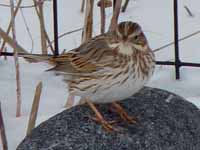

Genus Passerella - 1 species
Sparrow,_Fox Passerella iliaca
Description: Fox sparrows are amongst the largest sparrows (up to 19 cm), heavily spotted and streaked underneath. All feature a messy central breast spot though it is less noticeable on the thick billed and slate-colored varieties. Plumage varies markedly from one group to another with upperparts reddish. brown, or grey.
Range: Canda, western USA,.
Habitat: Thick stands of evergreens, woods with heavy undergrowth.
Diet: Fruits, seeds, insects, spiders.
Conservation status: Least Concern.
Image by: 1) Mdf - Whitby, Ontario, Canada 2) Elaine R. Wilson British Columbia 3) Alan D. Wilson - British Columbia 4) Dick Daniels - San Francisco, CA 5) Becky_Matsubara - CaliforniaRange: Canda, western USA,.
Habitat: Thick stands of evergreens, woods with heavy undergrowth.
Diet: Fruits, seeds, insects, spiders.
Conservation status: Least Concern.


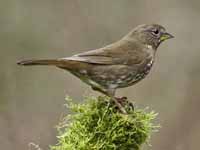


Genus Peucaea
These sparrows were formerly in genus Aimophila. They are medium sized sparrows with a relatively long bill and a long, graduated tail.They are found in southwestern USA through Central America. The diet consists of seeds, insect, and spiders with the animal material usually favored during breeding season.
Sparrow,_Bachman's Peucaea aestivalis
Description: The Bachman's sparrow has brown upperparts with black streaking. It has a grey crown, grey face, rufous-brown eye-stripe. The breast is buff and the belly is white.
Range: Southeastern United States.
Habitat: Open pine forests.
Diet: Seeds, insects.
Conservation status: It is listed as Near Threatened because of habitat loss.
Image by: 1, 2) Leppyone - Florida 3) Dan Irizarry 4) Daniel Berganza - FloridaRange: Southeastern United States.
Habitat: Open pine forests.
Diet: Seeds, insects.
Conservation status: It is listed as Near Threatened because of habitat loss.




Sparrow,_Black-chested Peucaea humeralis
Description: The black-chested sparrow has a rufous back. It has a mainly black head with white lores, white malar streak, and a white throat. The upper-breast is black while the lower breast and belly are white.
Range: Mexico.
Habitat: High altitude shrubland.
Diet: Insects; also seeds, fruits.
Conservation status: Least Concern.
Image by: 1) John Gerrard Keulemans 2) Ron Knight 3) Amado_DemesaRange: Mexico.
Habitat: High altitude shrubland.
Diet: Insects; also seeds, fruits.
Conservation status: Least Concern.

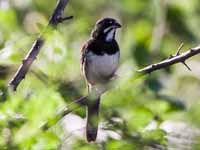

Sparrow,_Botteri's Peucaea botterii
Description: The Botteri's sparrow has streaked brownish-grey upperparts. It has a faint eye-line, faint pale supercilium, and a white eye-ring. The underparts are plain buff-grey. The Botteri's sparrow is up to 15 cm long. The similar Cassin's sparrow has a pale eye-ring while Botteri's is more distinct.
Range: Mainly Mexico; also southwest USA.
Habitat: Grasslands.
Diet: Mainly insects; also seeds.
Conservation status: Least Concern.
Image by: 1) Alastair Rae 2, 4) Jerry Oldenettel - New Mexico 3) Marcel Holyoak - ArizonaRange: Mainly Mexico; also southwest USA.
Habitat: Grasslands.
Diet: Mainly insects; also seeds.
Conservation status: Least Concern.




Sparrow,_Bridled Peucaea mystacalis
Description: The bridled sparrow has brown upperparts with black stripes, rufous shoulders, and a rufous rump. It has a light grey head, white malar stripes (leading to its "bridled" name), and a black throat. There is a white eye-ring interrupted by a thin black eye-line. The breast is grey and the belly whitish. The bridled sparrow is up to 17 cm long.
Range: Interior of southern Mexico.
Habitat: High altitude shrubland.
Diet: Probably seeds, insects, and spiders.
Conservation status: Least Concern.
Image by: 1, 2) Jerry Oldenettel 3) Francesco_Veronesi 4) Nick Athanas Range: Interior of southern Mexico.
Habitat: High altitude shrubland.
Diet: Probably seeds, insects, and spiders.
Conservation status: Least Concern.



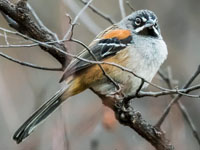
Sparrow,_Cassin's Peucaea cassinii
Description: The Cassin's sparrow has a brown upperparts including the head and wings. It has a buff supercilium, light brownish-grey bill, and dark brown eyes. The chin, throat, and breast are pale grey; the belly is whitish with some dark streaks on the lower flanks. The similar Botteri's sparrow has irregular white around eye while Cassin's sparrow has a pale eye-ring. They can best be differentiated by song.
Range: Southwest USA, Mexico.
Habitat: Grassy areas with bushes.
Diet: Seeds, insects, and spiders.
Conservation status: Least Concern.
Image by: 1) Jason Forbes - Colorado 2) Bill Bouton - Texas 3) Jerry_Oldenettel 4) Dominic SheronyRange: Southwest USA, Mexico.
Habitat: Grassy areas with bushes.
Diet: Seeds, insects, and spiders.
Conservation status: Least Concern.




Sparrow,_Cinnamon-tailed Peucaea sumichrasti
Description: The cinnamon-tailed sparrow has brown upperparts with black streaks. It has a dark brown crown with thin white median streak, grey face, white supercilium, long and curved black eye-line, two black streaks in the malar region that border a white region. It has a cinnamon tail and pale grey underparts.
Range: Southwestern Mexico.
Habitat: Brushy areas.
Diet: Seeds, insects, and spiders.
Conservation status: It is listed as Near Threatened because of its limited range.
Image by:
1, 2) Nick Athanas 3) Jerry OldenettelRange: Southwestern Mexico.
Habitat: Brushy areas.
Diet: Seeds, insects, and spiders.
Conservation status: It is listed as Near Threatened because of its limited range.
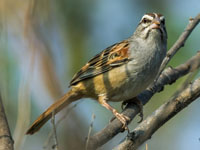
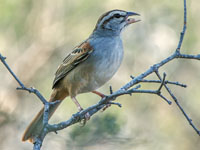

Sparrow,_Rufous-winged Peucaea carpalis (formerly Aimophila carpalis ) Found: North America
Description: The rufous-winged sparrow has a brown back with darker streaks and rusty wings. The crown is also rusty. It has pale grey face with a rufous eye-line plus a yellow bill. The underparts are grey and the long tail is brown. The similar rufous-crowned sparrow has a grey bill.
Range: Mainly northwestern Mexico; also southern Arizona and New Mexico.
Habitat: Desert grasslands,.
Diet: Seeds, insects, spiders. The insects are gleaned off plants are caught on the wing.
Conservation status: Least Concern.
Image by: 1) Jerry Oldenettel - New Mexica 2) Dominic Sherony 3) HarmonyOnPlanetEarth - Arizona 4) Greg_SchechterRange: Mainly northwestern Mexico; also southern Arizona and New Mexico.
Habitat: Desert grasslands,.
Diet: Seeds, insects, spiders. The insects are gleaned off plants are caught on the wing.
Conservation status: Least Concern.




Sparrow,_Stripe-headed Peucaea ruficauda
Description: The stripe-headed sparrow has pale brown upperparts streaked with black on the back. It has rufous shoulders, buffy-brown rump and tail, plus a grey nape. The head is black with a distinct but narrow white median crown stripe. The supercilium, throat, and breast are white; the flanks and belly are rufous. The stripe-headed sparrow is up to 18 cm long.
Range: Southwestern Mexico and western Central America.
Habitat: Open woodlands with shrubs; other areas with bushes.
Diet: Seeds; also insects and spiders.
Conservation status: Least Concern.
Image by: 1) Amado_Demesa - Mexico 2) Len Blumin 3) Don_Faulkner - Costa Rica 4) Ron_KnightRange: Southwestern Mexico and western Central America.
Habitat: Open woodlands with shrubs; other areas with bushes.
Diet: Seeds; also insects and spiders.
Conservation status: Least Concern.
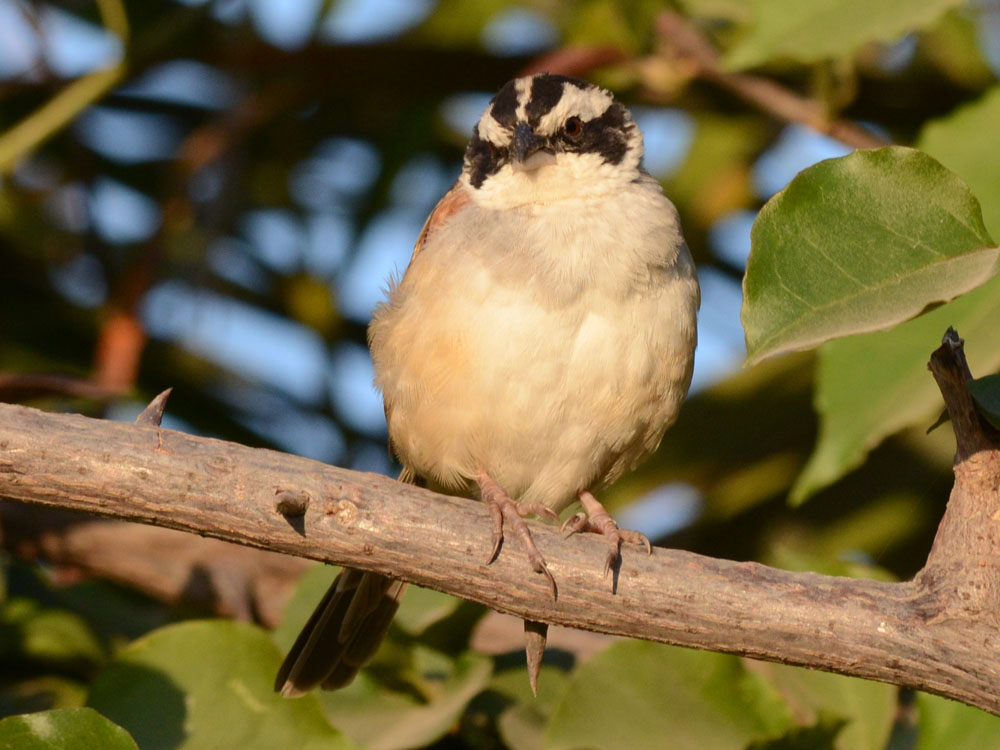



Genus Oriturus - 1 species
Sparrow,_Striped Oriturus superciliosus
Description: The striped sparrow has tawny-brown, grey and black upperparts. It has a rufous crown, white supercilium, and black mask. The underparts are pale grey. The striped sparrow is up to 19 cm long.
Range: Mexico.
Habitat: Grasslands with scattered shrubs.
Diet: Mainly seeds; also insects and spiders.
Conservation status: Least Concern.
Image by: 1) John Gerrard Keulemans 2) Amy McAndrews 3) Amado_Demesa 4) Pablo Leautaud Range: Mexico.
Habitat: Grasslands with scattered shrubs.
Diet: Mainly seeds; also insects and spiders.
Conservation status: Least Concern.



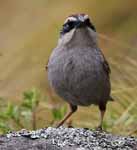
Genus Pooecete- 1 species
Sparrow,_Vesper Pooecetes gramineus
Description: The Vesper sparrow has light brown upperparts with darker streaking. It has a white eye-ring and white throat. The breast and flanks are pale streaked; the upper-tail is dark brown; there is white under the tail and the belly is off-white. The similar Savannah sparrow does not have a white eye-ring.
Range: North America.
Habitat: Dry grasslands, sagebrush and fields.
Diet: Seeds, insects, spiders.
Conservation status: Least Concern.
Image by: 1) Seabamirum 2) Jerry Oldenettel - New Mexico 3) Ken Schneider - Illinois 4) Bob Pruner Range: North America.
Habitat: Dry grasslands, sagebrush and fields.
Diet: Seeds, insects, spiders.
Conservation status: Least Concern.




Genus Rhynchospiza
Sparrow,_Stripe-capped Rhynchospiza strigiceps
Description: The stripe-capped sparrow, also known as the Chaco sparrow, has brown upperparts with dark streaks and also some rust and grey. It has a grey head with two cinnamon crown stripes and two post occular stripes plus dark lores. There is a white malar streak. The underparts are pale grey. The stripe-capped sparrow is up to 15 cm long.
Range: In the Chaco region of mainly Argentina, Paraguay; also Bolivia
Habitat: Dry forests and shrublands.
Diet: Probably seeds, insects, spiders.
Conservation status: Least Concern.
Image by:
1) Nick Athanas - ArgentinaRange: In the Chaco region of mainly Argentina, Paraguay; also Bolivia
Habitat: Dry forests and shrublands.
Diet: Probably seeds, insects, spiders.
Conservation status: Least Concern.

Sparrow,_Tumbes Rhynchospiza stolzmanni
Description: The Tumbes sparrow has greyish-brown upperparts with dark streaks. The wings are blackish-brown with white edgings. It has a grey crown with a dark chestnut median streak, a white supercilium, and a brown eye-line. The throat is white and the underparts are pale grey. The Tumbes sparrow is about 15 cm long.
Range: The Tumbes mountain range of Ecuador, and Peru.
Habitat: Dry forests and shrublands.
Diet: Seeds, insects, spiders.
Conservation status: Least Concern.
Image by: 1) Nick Athanas - Ecuador 2) Amy_McAndrews - PeruRange: The Tumbes mountain range of Ecuador, and Peru.
Habitat: Dry forests and shrublands.
Diet: Seeds, insects, spiders.
Conservation status: Least Concern.


Genus Spizella
These birds are fairly small and slim, with short bills, round heads and long wings. They are usually found in semi-open areas.
Sparrow,_Black-chinned Spizella atrogularis
Description: The black-chinned sparrow has rusty brown upperparts with black smudges. It has a grey head and underparts. The adult male has black at the front of the head. The black-chinned sparrow is up to 15 cm long.
Range: Southwest USA, Mexico.
Habitat: Dry shrublands.
Diet: Seeds, insects, spiders.
Conservation status: Least Concern.
Image by: 1) ALAN SCHMIERER - Arizona 2) Dominic_Sherony 3) Tom_Benson 4) Maggie Smith Range: Southwest USA, Mexico.
Habitat: Dry shrublands.
Diet: Seeds, insects, spiders.
Conservation status: Least Concern.
1) Female 2, 3, 4) Male




Sparrow,_Brewer's Spizella breweri
Description: The Brewer's sparrow has grey-brown back with brown wings. The crown is brown, there is a pale eye-ring, and pale grey underparts. It has a notched tail and a pale bill with dark tip. The Brewer's sparrow is up to 15 cm long. The similar clay-colored sparrow has a faint crown stripe; while the Brewer's sparrow lacks a crown stripe.
Range: Western North America.
Habitat: Shrubs and low vegetation.
Diet: Seeds, insects, spiders.
Conservation status: Least Concern.
Image by: 1) J. N. Stuart 2) naturespicsonline - Oregon 3) Seabamirum 4) Dick Daniels - Wyoming Range: Western North America.
Habitat: Shrubs and low vegetation.
Diet: Seeds, insects, spiders.
Conservation status: Least Concern.




Sparrow,_Chipping Spizella passerina
Description: The chipping sparrow has orangish-rust upperparts and grey underparts. The breeding chipping sparrow has a red cap, bold white superciliu, and ; black eye-line. While nonbreeding it has brownish cap, adusky supercilium, and a dark eye-line. The similar American tree sparrow and field sparrow do not have a clean a supercilium as the chipping sparrow.
Range: North America.
Habitat: Open woodlands, shrubland.
Diet: Seeds, insects, spiders.
Conservation status: Least Concern.
Range: North America.
Habitat: Open woodlands, shrubland.
Diet: Seeds, insects, spiders.
Conservation status: Least Concern.




Sparrow,_Clay-colored Spizella pallida
Description: The clay-colored sparrow has light brown upperparts with dark streaks on the back. It has a dark brown crown with light median stripe, white supercilium, light brown cheek patch, and white throat. The underparts are clay-colored underparts and the tail is notched. The similar Brewer's sparrow lacks a crown stripe. The clay-colored sparrow is up to 14 cm long.
Range: Mexico and the cnetral parts of North America.
Habitat: Shrubland and jack pines.
Diet: Seeds, insects, spiders.
Conservation status: Least Concern.
Image by: 1, 3) goingslo 2) Aaron_Maizlish 4) David MitchellRange: Mexico and the cnetral parts of North America.
Habitat: Shrubland and jack pines.
Diet: Seeds, insects, spiders.
Conservation status: Least Concern.

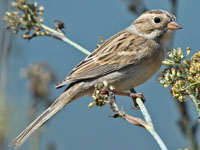


Sparrow,_Field Spizella pusilla
Description: The field sparrow has brown upperparts with white wing-bars. It has a grey face, rusty crown, white eye-ring, pink bill, and a faint supercilium. The breast is light brown breast and the belly white. The field sparrow is about 14 cm long. The similar American tree sparrow has a bicolored bill. The chipping sparrow. has a bold white supercilium.
Range: Central and esatern North America.
Habitat: Shrubland.
Diet: Seeds, insects, spiders.
Conservation status: Least Concern.
Image by: 1) Ken Schneider - Illinois 2) Andy_Morffew - Texas 3) Kelly Colgan Azar 4) Tom_Benson - Pennsylvania Range: Central and esatern North America.
Habitat: Shrubland.
Diet: Seeds, insects, spiders.
Conservation status: Least Concern.




Sparrow,_Worthen's Spizella wortheni
Description: The Worthen's sparrow has grey-brown upperparts with dark brown streaks and dark brown wing. It has a mainly grey head, rufous crown, and a pink bill. The underparts are grey. The Worthen's sparrow is up to 1 cm long.
Range: Northeast Mexico.
Habitat: Grassy areas with shrubs available.
Diet: Probably seeds, insects, spiders.
Conservation status: It is listed as Endangered because of habitat destruction in its small range.
Image by:
1) Jorge Montejo 2) Amy McAndrewsRange: Northeast Mexico.
Habitat: Grassy areas with shrubs available.
Diet: Probably seeds, insects, spiders.
Conservation status: It is listed as Endangered because of habitat destruction in its small range.


Genus Spizelloides - 1 species
Sparrow,_American Tree Spizelloides arborea
Description: The American tree sparrow has a rusty back with lighter streaks and brown wings with 2 white wing-bars. It has a rusty cap, grey face, rufous eye-line, and bicolored bill. The underparts are grey with light brown flanks and there is often a dark spot in middle of breast. The American tree sparrow is about 14 cm long. The similar chipping sparrow has a unicolor bill as does the field sparrow with its pink bill.
Range: North America not including Mexico.
Habitat: Tundra, boreal forests, bushes.
Diet: Seeds, insects, spiders; occasionally berries.
Conservation status: Least Concern.
Image by: 1) Dominic Sherony 2) Mdf - Whitby, Ontario, Canada 3) Kelly Colgan Azar 4) Factumquintus -
Whitby, Ontario, CanadaRange: North America not including Mexico.
Habitat: Tundra, boreal forests, bushes.
Diet: Seeds, insects, spiders; occasionally berries.
Conservation status: Least Concern.
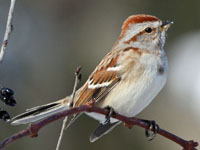



Genus Torreornis - 1 species
Sparrow,_Zapata Torreornis inexpectata
Description: The Zapata sparrow, also known as the Cuban sparrow, has olive-grey upperparts. It has a dark reddish-brown crown, grey face, black malar stripe, white throat, abd yellowish underparts.
Range: The Zapata Swamp region of Cuba and nearby areas.
Habitat: Sawgrass prairies, brushland.
Diet: Seeds, insects, spiders, snails.
Conservation status: It is listed as Near Threatened because of its small range and habitat degradation .
Image by: 1) Laura Gooch 2) Dominic Sherony 3) Charles_J_Sharp 4) Allan_HopkinsRange: The Zapata Swamp region of Cuba and nearby areas.
Habitat: Sawgrass prairies, brushland.
Diet: Seeds, insects, spiders, snails.
Conservation status: It is listed as Near Threatened because of its small range and habitat degradation .



Genus Xenospiza - 1 species
Sparrow,_Sierra_Madre Xenospiza baileyi
Description: The Sierra Madre sparrow, also known as Bailey's sparrow, has rufous upperparts streaked with black. It has blackish-brown crown stripes, grey ear coverts, and a black eye-line. The underparts are whitish with black streaking on the breast plus flanks and a hint of a breast spot. The Sierra Madre sparrow is only about 12 cm long.
Range: Mexico
Habitat: Montane grasslands and marshlands.
Diet: Seeds, insects, spiders.
Conservation status: It is listed as Endangered because of a limited range and habitat distruction for pastures.
Image by: 1) Dominic Sherony 2) Amy_McAndrewsRange: Mexico
Habitat: Montane grasslands and marshlands.
Diet: Seeds, insects, spiders.
Conservation status: It is listed as Endangered because of a limited range and habitat distruction for pastures.


Genus Zonotrichia
Zonotrichia sparrows have relatively long, square-tipped tail and a slightly peaked crown.
Sparrow,_Golden-crowned Zonotrichia atricapilla
Description: The breeding golden-crowned sparrow has streaked brown upperparts. It has a black crown, golden forehead, and light grey to brown underparts. The nonbreeding has a brown crown and pale yellow forehead. The similar white-crowned sparrow has no yellow on its head. The golden-crowned sparrow is up to 18 cm long.
Range: Western North America.
Habitat: Coastal in the winter; more inland other times in brush areas.
Diet: Seeds, insects, spiders, berries, buds.
Conservation status: Least Concern.
Image by: 1 Alan Vernon 2) Alexandra MacKenzie 3) Lucina M 4) Rick Leche 5) Gary Kramer 6) Dick Daniels - Hatcher Pass, Alaska Range: Western North America.
Habitat: Coastal in the winter; more inland other times in brush areas.
Diet: Seeds, insects, spiders, berries, buds.
Conservation status: Least Concern.
1) Juvenile 2, 3) Nonbreeding 4, 5, , 6) Breeding
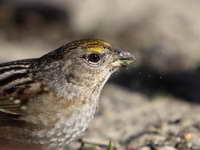

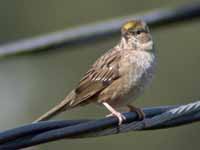
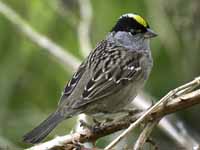

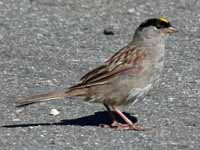
Sparrow,_Harris's Zonotrichia querula
Description: The breeding Harris's sparrow has a brown back with black streaking and 2 pale white wing-bars. It has a brown-and-black head, face, and throat plus a pink bill. The underparts are white with some black on the upper breast. The similar house sparrow has a black or yellowish bill.
Range: Central North America.
Habitat: Boreal forests and tundra in the summer; prairies and open woodlands in the winter.
Diet: Seeds, insects, spiders, berries, buds.
Conservation status: Least Concern.
Image by: 1) Norm Townsend 2) Jerry Oldenettel - New Mexico 3) Tom Smith - Oklahoma 4) Greg Schechter - California 5) Blake Maybank - California 6) Alan WilsonRange: Central North America.
Habitat: Boreal forests and tundra in the summer; prairies and open woodlands in the winter.
Diet: Seeds, insects, spiders, berries, buds.
Conservation status: Least Concern.
1) Juvenile 2) Nonbreeding 3) Eclipse 4, 5, 6) Breeding


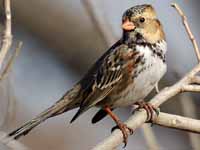



Sparrow,_Rufous-collared Zonotrichia capensis
Description: The rufous-collared sparrow has black-streaked buff-brown upperparts. It has a rufous collar, grey head with broad black crown stripes on either side of the median, black eye-line, and black malar line. The underparts are white. It has a stubby grey bill. The rufous-collared sparrow is up to 15 cm long.
Range: Mexico, Central America, South America.
Habitat: Open or semi-open habitats of various types.
Diet: Seeds, insects, spiders.
Conservation status: Least Concern.
Image by: 1) Dick Daniels - Boquette, Panama 2) Dick Daniels- Chile 3) Dick - Quito, Ecuador 4) Nick Athanas - Brazil, ColumbiaRange: Mexico, Central America, South America.
Habitat: Open or semi-open habitats of various types.
Diet: Seeds, insects, spiders.
Conservation status: Least Concern.




Sparrow,_White-crowned Zonotrichia leucophrys
Description: The white-crowned sparrow has brown-streaked upperparts with brown wings. It has black and white streaks on the head, a grey face, and a pink or yellow bill. The underparts are grey. The similar white-throated sparrow has a white throat.
Range: Most of North America.
Habitat: Brushland, tundra, conifer forests.
Diet: Seeds, insects, spiders.
Conservation status: Least Concern.
Image by: 1) Elaine R. Wilson - New Mexico 2) Dick Daniels - California 3) Andy_Morffew - Texas 4) Wolfgang_WanderRange: Most of North America.
Habitat: Brushland, tundra, conifer forests.
Diet: Seeds, insects, spiders.
Conservation status: Least Concern.
1) Juvenile




Sparrow,_White-throated Zonotrichia albicollis
Description: The white-throated sparrow has brown upperparts with rufous wings with 2 white wing-bars. It has a white throat, yellow lores, dark eyes, and a grey bill. One variation has black crown with white median stripe; white supercilium. Other variation has dark brown crown with tan median stripe; tan supercilium. The underparts are grey. The similar white-crowned sparrow has a grey throat.
Range: Most of North America except the west/
Habitat: Varied, but avoids dense forest.
Diet: Seeds, insects, spiders; also fruits.
Conservation status: Least Concern.
Image by: 1) Christopher Paquette 2) Cephas - Quebec 3) New
Jersy Birds 4) Dick Daniels - Maine 5, 6) Becky Gregory- Virginia tan morph Range: Most of North America except the west/
Habitat: Varied, but avoids dense forest.
Diet: Seeds, insects, spiders; also fruits.
Conservation status: Least Concern.
6) Tan morph






